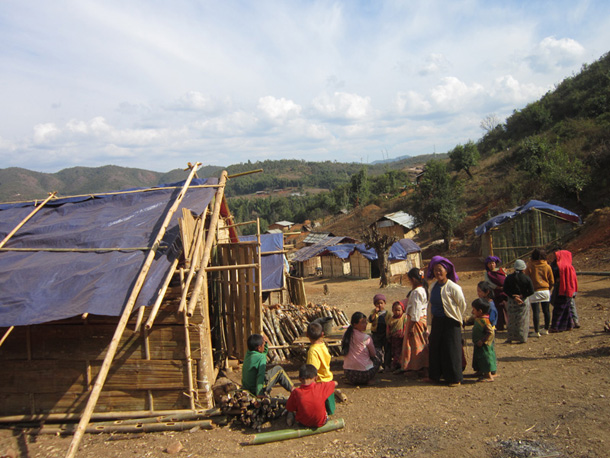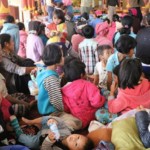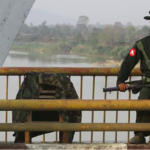Lawi Weng / The Irrawaddy, February 25, 2014
RANGOON — An ethnic Palaung women’s group has urged the Burma Army to cease its attacks on a Palaung rebel group in northern Shan State, saying that the local population suffered a range of human rights abuses at the hands of soldiers, while army operations have displaced more than 3,000 villagers last year alone.
During a press conference on Tuesday, the Ta’ang Women’s Organization (TWO) launched a report called “An Unseen Crisis” in order to highlight the plight of the Palaung civilian population affected by an increased military presence in their region.
“During late 2012 and 2013, the Burma Army launched fresh attacks against Shan, Kachin and Ta’ang
“Shelling of villages, destruction of houses and property, forced portering, torture and sexual violence [by the army] have caused over 3,000 mainly Palaung villagers in these areas to flee and set up four new camps,” according to the report, which said that the total number of internally displaced Palaung now stood at 4,000 people, a four-fold increase since 2012.
Lway Poe Ngeal, the joint general secretary 2 of TWO, called on the international community and the Burmese public to pay attention to the situation of the Palaung and the conflict between the Burma Army and the Ta’ang National Liberation Army (TNLA).
“Our report intends to let the people in Burma and the international community know, and increase pressure on the Burmese government to stop launching military operations in the Palaung region,” she said. “It is very important to stop the fighting in our region because our displaced people have suffered a lot and have great difficulty to survive.”
The Palaung are a Buddhist ethnic minority of around 1 million people living in the mountainous northern parts of Shan State. They are traditionally known for tea production, but the region has been affected by a rise in opium and methamphetamine production in the past decade.
The TNLA, which is believed to number about 1,500 soldiers, have been engaged in regular clashes with the Burma Army in the area in since 2011. The TNLA was formed that year with the help of the Kachin Independence Army (KIA), reportedly because the Palaung felt a need to protect their population from increasing Burma Army abuses and rising drug production.
Previously, the Palaung fought an armed insurgency against the central government but laid down their weapons in the 1990s. Like other ethnic groups in Burma, the Palaung aspire to greater political autonomy and feel oppressed by the Bamar majority-dominated central government.
Like the KIA, the TNLA has met for ceasefire talks with the government, but no agreement was reached. The Burma Army has also continued operations against the KIA that have affected Kachin civilians in Mansi Township, where thousands of villagers were displaced in recent months.
President Thein Sein’s reformist government has held talks with many rebel groups since 2012 and signed 15 ceasefire agreements. Naypyidaw is currently seeking a joint nationwide ceasefire agreement with all rebel groups but this is proving elusive.
The new TWO report said the Burma Army had increased the number of battalions in the region had sharply risen last year from 16 to 30, adding that the expanding military operations “call into to question the Burmese government’s claims to be seeking a peaceful settlement to the ethnic conflict.”
TWO alleges that the Burma Army is increasing its presence in the areas in order to secure the pathway along the Shwe oil and gas pipeline. This Chinese mega-project runs from the Arakan State coast through central Burma to Kunming, connecting southern China to Burmese offshore gas fields in the Bay of Bengal. Planned hydropower dam projects on the Salween River are reportedly also causing further militarization in parts of Shan State.
“There has been fighting in our region since 2011 and there is still ongoing fighting, even though the government said that they are making peace with the armed ethnic groups,” said Lway Poe Ngeal.
Sexual harassment by soldiers, forced labor and shelling near Palaung villages has caused thousands of villagers to flee to makeshift camps, she said. These camps remained isolated and received little to no international aid support during the past two years, Lway Peo Ngeal said, adding that the displaced struggle to survive due to a lack of livelihoods. Children in many of the camps had gone for many months without education.
“There is a political transition in our country and we found that [international] humanitarian aid groups offered aid in the country. But, those aid offers did not reach our displace people,” she said, referring to UN aid support for many of the roughly 100,000 displaced Kachin and approximately 140,000 displaced Rohingya Muslims.
At Thoe Hone camp, north of Manton Township, 500 displaced Palaung villagers struggled to survive without aid support since 2012, and so eventually the villagers decided to return to Pan Khar village last year, only to find their homes “entirely destroyed, burned down or dismantled by the Burma Army,” TWO said, adding that the area was not yet safe and an 18-year-old boy had died after stepping on a land mine.
This news story originally appeared in The Irrawaddy. Vew the original article here.






